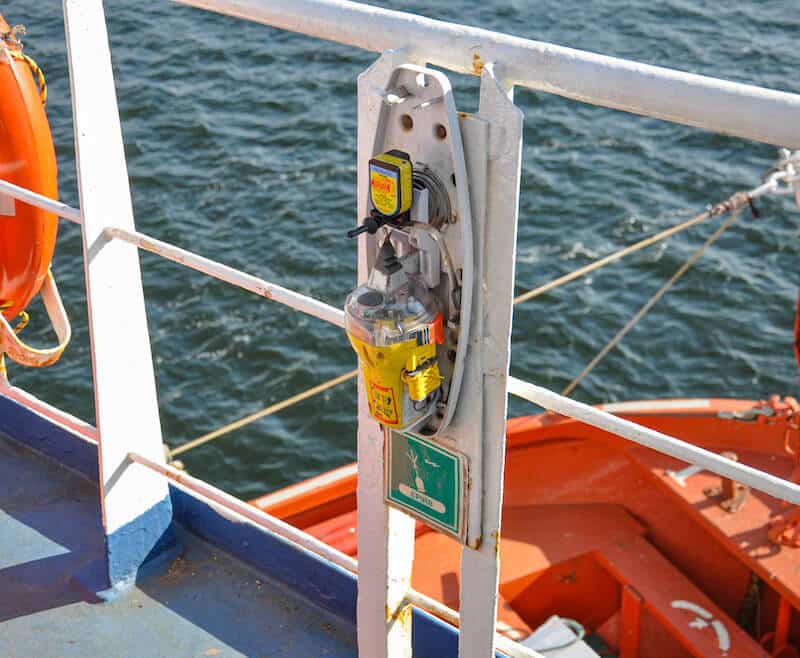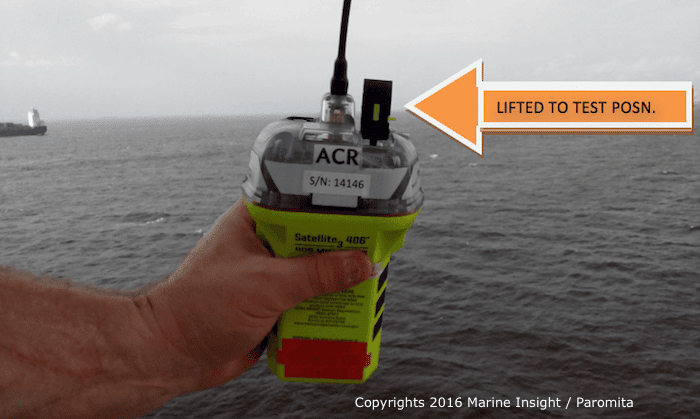![]()
EPIRB- What does it stand for?
An Emergency Position-Indicating Radio Beacon (EPIRB) is a device that alerts search and rescue services (SAR) in case of an emergency at sea. It is a tracking equipment that transmits a signal on a specified band to locate a lifeboat, life raft, ship, or people in distress.
An EPIRB is sometimes called a GPIRB, which means an EPIRB with a GPS receiver to find your precise location faster.
What is EPIRB used for?
EPIRB is a distress beacon that, once activated, alerts a global search and rescue network to send help to your location as quickly as possible.
EPIRBs are installed on ships after being registered with the national search and rescue forces for that boat. The registration allows confirmation of false alerts and faster rescue operations.
An EPIRB is a SECONDARY means of DISTRESS alerting, which means that it comes later in the hierarchy of alerting SAR authorities in case of distress.
It is mandatory to carry one EPIRB on every ship and two EPIRBS for all Registered ships (and other types of vessels).
When Should an EPIRB be Activated?
An EPIRB should only be activated at times of great danger or maritime emergency, such as a ship sinking or medical emergency onboard.
Different Types Of EPIRBs
- COSPAS-SARSAT– EPIRBS under the COSPAS-SARSAT system work on the 406.025 MHz and 121.5 MHz bands and are applicable for all sea areas
- INMARSAT E– This EPIRB works on a 1.6 GHz band. These are applicable for sea areas A1, A2 and A3.
- VHF CH 70– This works on the 156.525 MHz band and is applicable for sea area A1 only
How Does An EPIRB Work?
The device contains two radio transmitters, a 5-watt one and a 0.25-watt one, each operating at 406 MHz, the standard international frequency typically signalling distress, 406MHz.
The 5-watt radio transmitter is synchronised with a GOES weather satellite going around the earth in a geosynchronous orbit.
The COSPAS-SARSAT is an international satellite-based search and rescue system founded by the U.S., Russia, Canada and France to detect emergency radio beacons.
Due to the many advantages of 406 MHz beacons and the disadvantages of the 121.5 MHz beacons, the International Cospas-Sarsat Program stopped the satellite processing of 121.5 MHz by satellites on February 1st, 2009. Encouragements were given by the National Oceanic and Atmospheric Administration/ NOAA and FAA to switch to 406 for obvious reasons.
However, aircraft might still use the Emergency Locator Transmitter, and alerts from these devices would not be acted upon unless confirmed by two other independent non-satellite sources or devices.

An EPIRB transmits signals to the satellite. The signal consists of an encrypted identification number (all in digital code), which holds information such as the ship’s identification, event date, the nature of distress, emergency contacts and position.
A UIN is a Unique Identifier Number programmed into each beacon at the factory. The UIN number consists of a 15-digit series of letters and numbers that make up the unique identity of the beacon. The UIN is on a white label on the exterior of the beacon. The UIN is also referred to as the Hex ID.
The Local User Terminal (satellite receiving units or ground stations) calculates the position of the casualty using Doppler Shift (which is the change in frequency or wavelength of a wave (or other periodic events) for an observer moving relative to its source).
The LUT passes the digital message to the MRCC (Mission Rescue Co-Ordination Centre). Furthermore, the MRCC is responsible for the SAR ops and oversees the execution of the rescue mission.

If the EPIRB is not compatible with a GPS receiver, the geosynchronous satellite orbiting the earth can pick up only the radio signals emitted by the radio. In this case, the location of the transmitter or the identity of the owner cannot be deduced.
These satellites can only pick up trace elements of such signals and can only give a rough idea of the location of the EPIRB. Per international standards, a signal of 406MHz is treated as an emergency signal.
The signal could help you locate the transmitter, even if it is 3 miles away. If the EPIRB is registered, the vessel or the individual in distress could be identified.
If an emitter transmits signals of 121.5 MHz, the rescuer or concerned party can reach the lost person even if they are 15 miles away. The accuracy of reaching the target could be magnified if an EPIRB also contains a GPS receiver.
Using an EPIRB During Times of Emergency
You can activate EPIRBs manually or even automatically, depending on the EPIRB type, category, and situation.
An automatic category I bracket can release EPIRB when the HRU or Hydrostatic Release Unit is submerged in 4 to 14 ft or 1.5 m to 4 m deep water. In an emergency, this type of EPIRB releases itself and floats to the surface, alerting search and rescue.
Category II EPIRBs must be manually activated by pressing a button on the unit. They are usually mounted above or below a ship’s deck.
Since EPIRBs are designed to get activated when submerged in water, they can accidentally get activated if they come out of the bracket and come in contact with water, hence creating a false alarm.
New Zealand and Australia have a Class 3 type of EPIRB that does not activate when submerged in water. It can only be switched on manually.
The EPIRB needs activation to be operative, and this can happen only when it is released from the bracket it is placed in. As said earlier, this can be done manually or automatically. The device is essentially battery-operated, which helps because power is the first to be affected in case of a calamity.
When to replace the battery of EPIRB?
The expiry date of the battery is mentioned on the EPIRB. However, it should be replaced every 2 to 5 years.
EPIRBS have:
- 12 Volt battery
- 48 hours of transmitting capacity
Different EPIRB Brackets
- Category I Brackets automatically activate the EPIRB, while Category II Brackets require activating the EPIRB manually.
- Category I Brackets have an HRU that must be replaced every 24 months.
- Both categories of brackets have a deactivation water sensor to prevent false alarms.
- Both allow manual activation while the EPIRB is in the bracket, given that its antenna is positioned to the skies.
- Category I Brackets protect EPIRB from extreme weather and UV Rays.
What is False Alerting?
An individual onboard might mistakenly activate the EPIRB and send false alarms. If this happens, the nearest coast station or RCC (Rescue Co-Ordination Center) must be informed immediately and cancelled.
The cancellation intimation must also be sent to the appropriate authority (for example, DG Shipping for Indian Registered Ships or ships plying in Indian waters when the false alert is transmitted). The shipowner and the agent must also be informed.
![]()
How to test an EPIRB?
The EPIRB should be tested once a month to ensure operational integrity. The procedure to do so is as follows:
- Press and release the test button on the EPIRB
- The red lamp on the EPIRB should flash once
- Within 30 seconds of pressing the button, the strobe, as well as the red light, should flash several times
- After 60 seconds of operation, the EPIRB will switch off
Maintenance of EPIRB
- The EPIRB must be inspected visually for any defects, such as cracks
- It is advisable to clean the EPIRB once in a while with a dry cloth
- While cleaning, the switches must be specifically checked
- The lanyard of the EPIRB must be neatly packed into the container of the EPIRB without any loose ends dangling about
- The expiry date of the battery must be checked to cover the immediate as well as the next voyage at the least
- Send the EPIRB back to the service agent or the supplier if the EPIRB fails the monthly checks
- Change the battery onboard if the facilities are available or send it to the servicing agent if there isn’t
- If the EPIRB has been used in an emergency, it must be returned to an authorised service agent for a battery change.
- If the HRU has passed its expiry date, it ought to be replaced on board and marked with an expiration date of two years in the future.
What do you mean by Return Link Service or RLS?
There are RLS-enabled EPIRBs with a blue flashing LED light, which confirms that Search and Rescue has received your distress message and precise location. A Return Link Service Signal is sent via the Galileo Satellite Network.
This gives great comfort to those facing the maritime emergency, knowing they have been identified and help is on its way.
Registering an EPIRB
You can register an EPIRB with the local government if you buy a new or used 406 MHz beacon.
If you change your mobile number, address or any other information, you must update the beacon registration.
If you sell the beacon, let the local authorities know so the buyer can register it. Otherwise, you might be contacted if it is activated.
Registration Renewal for EPIRB
The registration of EPIRBs with serial numbers must be renewed every two years for recreational boats.
Registrations can be updated online, and you can add trip details to the registration as well.
The more information you give and the more frequently you update the registration, you give rescuers all the details they might need to expedite your rescue.
Is there any EPIRB Subscription Fee?
You don’t have to pay any fees once you own an EPIRB or Personal Locator Beacon. On the contrary, if you ever activate your beacon, rescue is free of cost in many countries.
Advantages of a GPS EPIRB
An EPIRB with an inbuilt GPS decreases the search radius to 100 m and reduces notification time from less than 60 minutes to 60 seconds.
If the beacon has GPS coordinates then the GEOSAR satellites alert the Search and Rescue in about two to three minutes.
LEOSAR satellites, being low-earth orbiting, take around an hour to alert search and rescue of your location.
Regulations
EPIRBs must be carried on most vessels, including fishing vessels, passenger ships, and commercial ships. Some nations mandate that they be carried on recreational boats that go more than a particular distance offshore.
The IMO regulates the carriage of EPIRBs on vessels in international waters, and several nations apply the IMO regulations to ships in their waters.
Difference Between EPIRB & PLBs or Personal Locator Beacon
PLBs are EPIRBs for individual entities. They indicate distress for an individual not in the proximity of emergency services. PLBs work like EPIRBS and transmit on the COSPAS SARSAT satellite system at 406.025 MHz. They are much smaller in size than EPIRBs. They work all over the world, at sea and on land.
They should be kept in a safe place on the vessel, in a ditch bag, or in an easily accessible spot. Some have strobe lights that can be manually or automatically activated.
Once activated, PLBs transmit for a minimum of 24 hours, while the battery life on an EPIRB is at least double (a minimum of 48 hours). An EPIRB is registered to a vessel, whereas a PLB is registered to an individual.
The EPIRB is an essential emergency equipment available onboard in case of distress. It must be given considerable time to care for, test, and maintain itself so that it functions at its optimum level when the situation arises.
You might also like to read:
- Liferafts: SOLAS Requirements, Safety Features & Launching Procedure
- Safety of Life at Sea (SOLAS); The Ultimate Guide
- Daily, Monthly And Weekly Tests Of GMDSS Equipment On Board Ships
- What is Search and Rescue Transponder (SART)?
- Types of Life-Saving Equipment Onboard Ships
